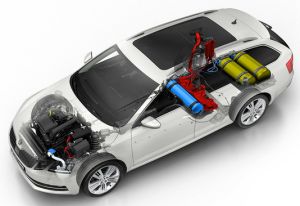Exclusively available with a COMBI body and the Active, Ambition or Style equipment lines, the ŠKODA OCTAVIA G-TEC achieves a range of 480 kilometres in its more eco-friendly pure CNG mode.
 The new 1.5-litre engine in the ŠKODA OCTAVIA G-TEC has an output of 96 kW (130 PS) – 15 kW (20 PS) more than its predecessor. Thanks to variable intake valve timing with Miller cycle operation, it is also very efficient. In CNG mode, CO2 emissions are reduced even further, by around 25 per cent compared to petrol, with considerably lower nitrogen oxide (NOx) output and no particulate emissions. As a result, the ŠKODA OCTAVIA G-TEC complies with EU6d-TEMP, the most stringent current emissions standard, making it an eco-friendly alternative to cars running on conventional fuels.
The new 1.5-litre engine in the ŠKODA OCTAVIA G-TEC has an output of 96 kW (130 PS) – 15 kW (20 PS) more than its predecessor. Thanks to variable intake valve timing with Miller cycle operation, it is also very efficient. In CNG mode, CO2 emissions are reduced even further, by around 25 per cent compared to petrol, with considerably lower nitrogen oxide (NOx) output and no particulate emissions. As a result, the ŠKODA OCTAVIA G-TEC complies with EU6d-TEMP, the most stringent current emissions standard, making it an eco-friendly alternative to cars running on conventional fuels.
The three CNG tanks in the ŠKODA OCTAVIA G-TEC have a total capacity of 17.7 kilograms. The tank positioned in front of the rear axle is made of steel. The other two tanks, situated under the luggage compartment, are fashioned from a new composite material that combines ultimate safety with low weight. When operated on CNG alone, the OCTAVIA G-TEC can cover a range of around 480 kilometres. Should the CNG supply run out, the car will automatically switch to petrol mode, using 11.8 litres of petrol carried in an additional tank.
The ŠKODA OCTAVIA G-TEC 1.5 TSI is available with the Active, Ambition and Style equipment lines, in COMBI format only, and comes with a seven-speed DSG transmission. The ŠKODA Connect online services for the G-TEC also include the Emergency Call and Care Connect. The ŠKODA Connect app, for example, shows the driver the remaining CNG, petrol and overall range.
Source: www.skoda-auto.com

I ordered the new Skoda Octavia G-Tec 2019 (Style with some extras) as soon as available in March 2019. The indicative delivery time was September 2019. This was really disappointing. Surprisingly I received mid May the message that my car is available.
I took over beginning of June and can already now confirm: an excellent car for everyday use. Motorway consumption is about 3.5 kg/100 km; mixed use consumption is 4.0 kg/100km. For Germany with the current electricity mix CNG cars are clearly preferred over e-mobility. I wonder why CNG is not better promoted by automotive Industry as an immediate improvement of CO2, NOx and particle Emission. Another argument is clearly the use of bio-methane where available.